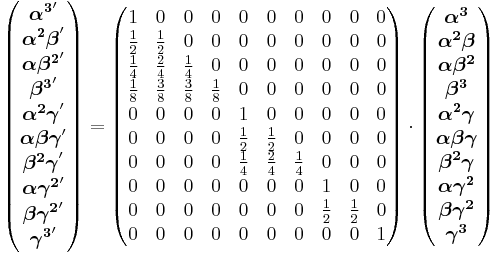Bézier triangle
A Bézier triangle is a special type of Bézier surface, which is created by (linear, quadratic, cubic or higher degree) interpolation of control points.
Contents |
Cubic Bézier Triangle
A cubic Bézier triangle is a surface with the equation
where α3, β3, γ3, α2β, αβ2, β2γ, βγ2, αγ2, α2γ and αβγ are the control points of the triangle and s, t, u (with 0 ≤ s, t, u ≤ 1 and s+t+u=1) the barycentric coordinates inside the triangle.[1] [2]
The corners of the triangle are the points α3, β3 and γ3. The edges of the triangle are themselves Bézier curves, with the same control points as the Bézier triangle.
By removing the γu term, a regular Bézier curve results. Also, while not very useful for display on a physical computer screen, by adding extra terms, a Bézier tetrahedron or Bézier polytope results.
Due to the nature of the equation, the entire triangle will be contained within the volume surrounded by the control points, and affine transformations of the control points will correctly transform the whole triangle in the same way.
Halving a Cubic Bézier Triangle
An advantage of Bézier triangles in computer graphics is, they are smooth, and can easily be approximated by regular triangles, by recursively dividing the Bézier triangle into two separate Bézier triangles, until they are considered sufficiently small, using only addition and division by two, not requiring any floating point arithmetic whatsoever.
The following computes the new control points for the half of the full Bézier triangle with the corner α3, a corner halfway along the Bézier curve between α3 and β3, and the third corner γ3.

- equivalently, using addition and division by two only,
|
|||||||||||||||
|
|||||||||||||||
|
- where := means to replace the vector on the left with the vector on the right.
- Note that halving a bézier triangle is similar to halving Bézier curves of all orders up to the order of the Bézier triangle.
nth-order Bézier Triangle
It is also possible to create quadratic or other degrees of Bézier triangles, by changing the exponent in the original equation, in which case there will be more or fewer control points. With the exponent 1 (one), the resulting Bézier triangle is actually a regular flat triangle. In all cases, the edges of the triangle will be Bézier curves of the same degree.
A general nth-order Bézier triangle has (n + 1)(n + 2)/2 control points a i ß j γ k where i, j, k are nonnegative integers such that i + j + k = n. The surface is then defined as
for all nonnegative real numbers s + t + u = 1.
See also
- Bézier curve
- Bézier surface (biquadratic patches are Bézier rectangles)
- Surface
References
- ^ 3D Surface Rendering in Postscript, http://www.math.ubc.ca/~cass/courses/m308-03b/projects-03b/drader/main.htm
- ^ Farin, Gerald (2002), Curves and surfaces for computer-aided geometric design (5 ed.), Academic Press Science & Technology Books, ISBN 978 1 55860737 8
External links
- Quadratic Bézier Triangles As Drawing Primitives Contains more info on planar and quadratic Bézier triangles.
- Paper about the use of cubic Bézier patches in raytracing (German)
- Ray Tracing Triangular Bézier Patches
- Triangular Bézier Clipping
- Curved PN triangles (a special kind of cubic Bézier triangles)
- Pixel-Shader-Based Curved Triangles
- Surface Construction with Near Least Square Acceleration based on Vertex Normals on Triangular Meshes

